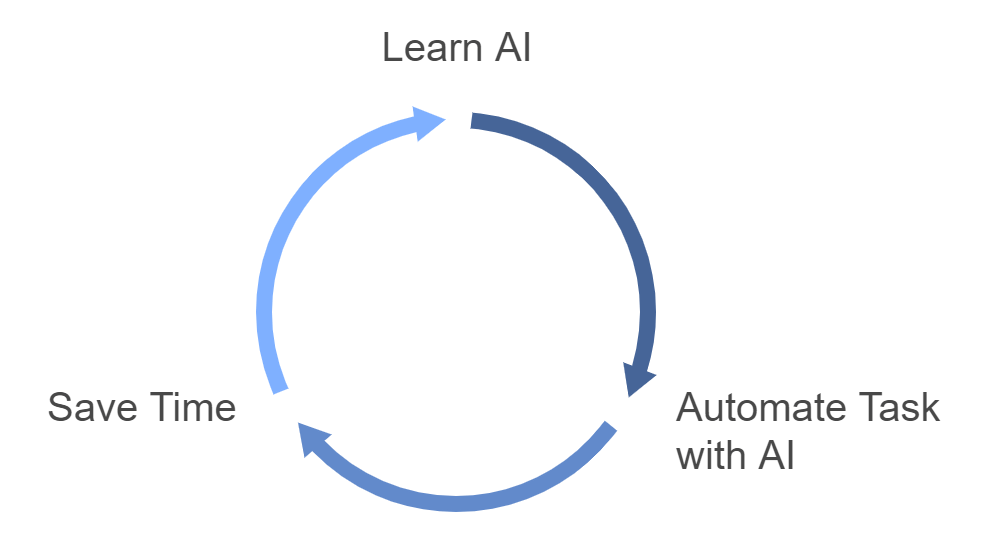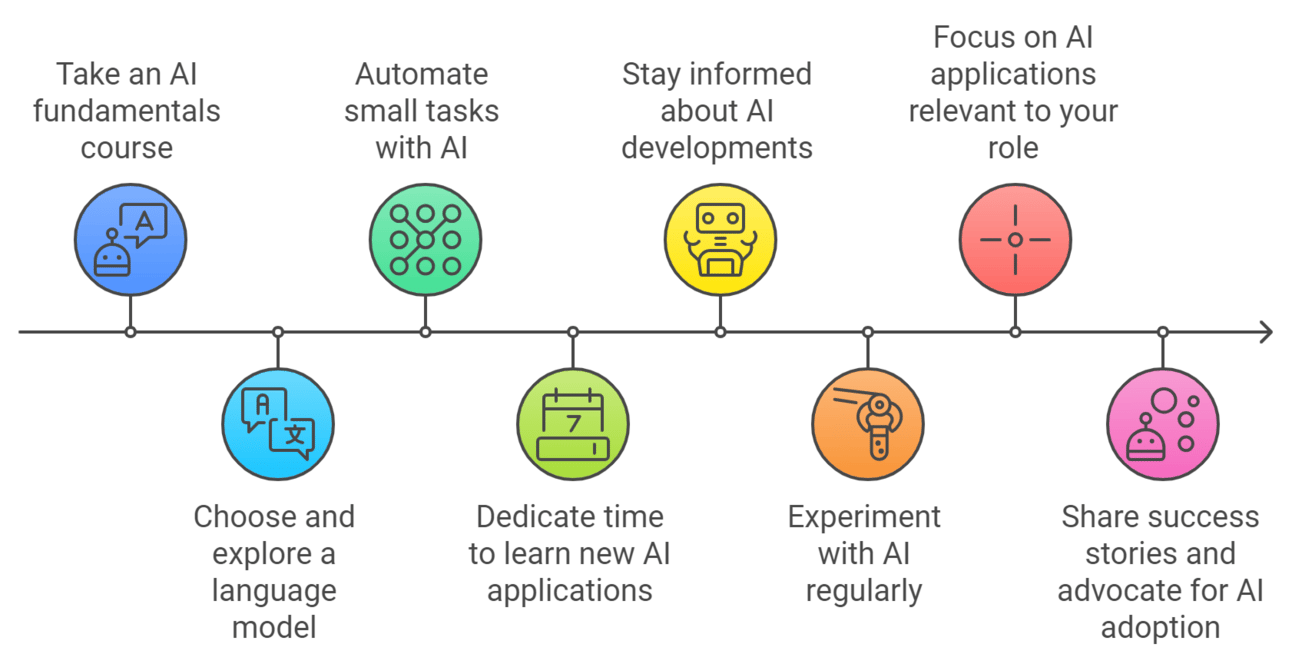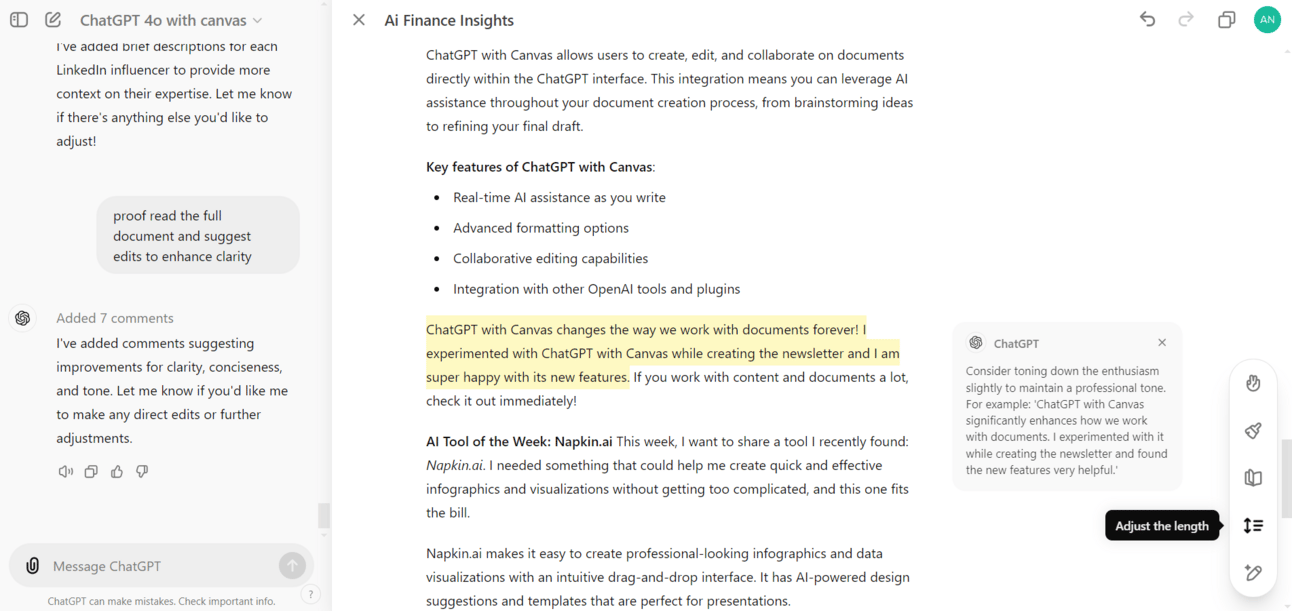Recently, I've heard so many people say how overwhelming it is to keep up with all the AI news. And honestly, I get it. There's this constant fear of missing out.
I spend at least five hours a week reading newsletters, watching webinars, and catching up on AI updates—and I still feel like I'm barely scratching the surface.
In my over ten years as an executive, I've never encountered a technology that makes you feel like you need to do all the running you can do to keep in the same place.
In this week's edition, I want to share why I'm more convinced than ever that every professional needs to learn AI. I'll also give you a step-by-step guide you can use to get started yourself or pass along to someone else who needs it.
The Balanced View: Why All Professionals Should Learn AI Now
When I started diving into AI six months ago, I was skeptical. 'Use AI' was the slogan everywhere, but having seen my share of tech bubbles, I knew it could be just another dead end. Back then, ChatGPT was still on version 3.5 with no advanced analytics, and other LLMs were far behind.
I threw myself into everything AI-related I could find. I attended countless webinars, but soon realized only a small fraction of the content was useful. I took a structured course, pretty expensive and 40 hours long—but honestly, only five hours of it were truly valuable. It was a lot of effort for just a few nuggets.
The real change came when I started experimenting. I began with simple tasks—writing emails and summarizing policies using AI. That's when I realized: the only real way to learn AI is to use it. I adopted an 'AI-First Approach,' and started asking myself if AI could help with every task. Gradually, AI began saving me time, and before I knew it, it was the foundation of my new business.
Now, AI is part of my everyday routine. I'm finding new, creative ways to leverage it—ways most people haven't thought of yet—and I'm helping other professionals, teams, and firms get started too.
Six months in, I am convinced that AI is the future, and everyone needs to learn it!
Starting now is more complex than it was six months ago, and it will only get more challenging as AI evolves.
Why? Six months ago, ChatGPT was the leading LLM, and there weren't many alternatives. Now, we have Google Gemini, Claude, Llama, and more, each better suited for different tasks. Navigating these options is a challenge in itself.

We now need to distinguish between different models of the same LLM. Just a few weeks ago, ChatGPT released the o1 model, and now we have ChatGPT with Canvas. Plus, there's a surge in AI tools for visuals, presentations, and more. Models are improving, and the possibilities are expanding faster than ever.
If you haven’t started, start today! Set aside some time to learn the basics. Use AI to automate a task, save time, and use that time to keep learning.

How To Start Learning AI: Share with Someone Starting Their AI Journey
Do a short AI basics course: Start with a foundational course that covers AI fundamentals, machine learning basics, and an overview of natural language processing. "Introduction to Artificial Intelligence (AI)" by IBM or Google's "Introduction to Generative AI" are great starting points.
Choose your LLM (If you don't know where to start, choose ChatGPT): you can start with a free subscription, but it would be better to get a Plus subscription or talk your company into getting a Team subscription. As you progress, explore other models like Gemini, Copilot, or Claude to understand their unique strengths and applications.
Start using it for small, repetitive tasks: Begin with tasks that are low-risk but high-frequency in your daily work. Here are some examples:
• Draft routine emails like report distribution or data collection notices
• Summarize reports or lengthy policy documents
• Format and clean data from various sources
• Create simple templates
Remember to always review and verify AI-generated content, especially when dealing with financial information.
Expand usage and set aside time to experiment: Once you're comfortable with basic tasks, allocate dedicated time each week to explore more complex applications. Consider setting a goal to learn one new AI application each week.
Remember to keep a time buffer—AI can sometimes fail, so be prepared to revert to traditional methods if needed.
Stay informed: The AI landscape is evolving rapidly. Make it a habit to stay updated:
• Subscribe to AI-focused newsletters
• Listen to AI podcasts/YouTube during your commute
• Follow AI thought leaders
• Join online communities or forums focused on AI in finance
Never stop experimenting: AI capabilities are expanding constantly. Regularly revisit tasks you thought weren't suitable for AI and see if new developments have changed that.
Keep an "AI ideas" document where you write down potential applications as they occur to you.
Stay focused on your area of work: While it's exciting to explore AI's possibilities, remember to prioritize applications relevant to finance and your specific role. Don't get sidetracked by every new AI development; instead, ask yourself, "How can this improve our processes or decision-making?"
Become an AI evangelist at your organization: Share specific success stories, such as how AI saved time or improved accuracy in a project. Suggest concrete AI use cases, like automating routine data analysis or enhancing reporting. Offer to host a workshop or write a short guide on how to start using AI. By sharing practical examples and helping others, you will position yourself as the go-to person for AI initiatives in your organization.

My Recommendations for Staying Informed
Newsletters:
Superhuman AI: Master AI Tools, Tutorials & News in Just 3 Mins A Day
The Algorithm by MIT Technology Review: A beginner-friendly newsletter that provides insights into AI trends and their implications in business.
YouTube Channels:
The AI Advantage explores the newest AI use cases
AI Foundations teaches to leverage market-moving AI tools.
LinkedIn Influencers to Follow (with a focus on Finance and AI):
Tobias Zwingmann - AI expert helping finance professionals implement practical AI
Nicolas Boucher posts about leveraging AI for data analysis and business intelligence.
Glenn Hopper is a finance executive with a strong focus on AI-driven financial strategy.
As you explore these resources, always think about how the concepts can apply to your work. The most valuable learning comes from hands-on experimentation, so don't be afraid to try new things!
AI News of the Week: ChatGPT with Canvas
Just a few weeks after the ChatGPT o1 model was released, we have a revolutionary ChatGPT with Canvas release. This new feature essentially mixes an LLM with a word processor, creating a powerful tool for document creation and editing.
ChatGPT with Canvas allows users to create, edit, and collaborate on documents directly within the ChatGPT interface. This integration means you can leverage AI assistance throughout your document creation process, from brainstorming ideas to refining your final draft.
Key features of ChatGPT with Canvas:
Real-time AI assistance as you write
Advanced formatting options
Collaborative editing capabilities
Integration with other OpenAI tools and plugins
ChatGPT with Canvas significantly enhances how we work with documents. I experimented with it while creating the newsletter and found the new features very helpful. If you work with content and documents a lot, check it out immediately!

ChatGPT with Canvas working on my newsletter
AI Tool of the Week: Napkin.ai
This week, I want to share a tool I recently found: Napkin.ai. I needed something that could help me create quick and effective infographics and visualizations without getting too complicated, and this one fits the bill.
Napkin.ai makes it easy to create professional-looking infographics and data visualizations with an intuitive drag-and-drop interface. It has AI-powered design suggestions and templates that are perfect for presentations.
Best of all, it's free!
What other tools or use cases do you want me to explore? Drop me a note with a suggestion!
Closing Thoughts
AI in finance is evolving rapidly, offering new opportunities—start learning now to enhance your work and drive innovation.
Start small, experiment often, and stay curious. Mistakes are part of the journey. As you grow comfortable with AI, you'll find new ways to use it in your financial processes and decision-making.
Take your first step this week. Experiment with ChatGPT, create a visualization with Napkin.ai, or set aside time to learn AI basics. As the Cheshire Cat said, 'Every adventure requires a first step.'
We Want Your Feedback!
This newsletter is for you, and we want to make it as valuable as possible. Please reply to this email with your questions, comments, or topics you'd like to see covered in future issues. Your input shapes our content!
Want to dive deeper into balanced AI adoption for your team or your firm? Or do you want to hire an AI-powered CFO? Book a consultation!
Did you find this newsletter helpful? Forward it to a colleague who might benefit!
Until next Tuesday, keep balancing!
Anna Tiomina
CFO & AI Enthusiast
